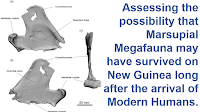Body ornamentation appears to have been a key piece of Human behaviour from the dawn of our species, and in Island Southeast Asia traces of such ornamentation, or other forms of artistic expression, is often the first evidence of Homo sapiens moving into an area. For a long time, rock art and shell beads from this region have automatically been assumed to be of Holocene age, but in the past decade it has become clear that many such items are much older, and that Modern Humans may have been active in the area as much as 50 000 years ago.
In a paper published in the journal Antiquity on 15 August 2023, Michelle Langley of the Australian Research Centre for Human Evolution and School of Environment and Science at Griffith University, Shimona Kealy of Archaeology and Natural History and the ARC Centre of Excellence for Australian Biodiversity and Heritage ar the Australian National University, Mahirta of the Departemen Arkeologi at the Universitas Gadjah Mada, and Sue O’Connor, also of Archaeology and Natural History and the ARC Centre of Excellence for Australian Biodiversity and Heritage ar the Australian National University, report the discovery of crafted beads made from the shells of Nautilus pompilius from Alor Island in the Eastern Lesser Sunda Islands, which can be directly dated to about 12 000 years before the present.
The beads were found in Makpan Cave, a lava tube between the modern villages of Halmin and Ling Al on the southwest coast of the island. The entrance to the cave is currently 386 m from the shoreline, and 37.5 m above sealevel. Since Alor Island is extremely steep sided, the cave would have been within easy walking distance of the sea, even during Pleistocene low sealevel stands.
Location of Makpan on Alor Island, Indonesia (A)–(B) and site context showing main excavation pit outlined with range poles (C)–(D). Shimona Kealy in Langley et al. (2023).
Excavations at the cave were carried out by a joint team from the Australian National University and Universitas Gadjah Mada in June-July 2016. A 2 m x 2 m trench was excavated in four blocks (A, B, C, and D) in a series of 5 mm 'spits', down to a depth of 1.5 m, then a single block (B) was further excavated down to a depth of 3.5 m, where beach sand sterile of artefacts was found. Because only block B was excavated tor the full extent of the occupation, Langley et al. concentrate on this block in their study.
Stratigraphic sections for the upper 2 × 2m excavation at Makpan. Langley et al. (2023).
Dating of the sequence was based upon charcoal where this was found, and marine shells where it was not. Occupation of the site was divided into five phases. Phase 1 began about 43 076 years before the present, and lasted for about 28 000 years, incorporating spits 68-58. Phase 2 covers the Terminal Pleistocene, beginning from about 13 965 years before the present, and incorporates spits 57-37. Phase 3 is a substantial shell midden comprising spits 36-21, believed to have been laid down at the Pleistocene–Holocene transition, starting from about 11 805 years before the present. Phase 4 covers the Early-Middle Holocene, starting from about 10 430 years before the present, and comprising spits 20-9. Phase 5 comprises Neolithic deposits, starting from about 3663 years before the present, and comprises spits 8-1. There are some detectable gaps in this record, most notably one of about 3500 years between the end of Phase 2 and the start of Phase 1, with a shorted gap between Phase 3 and Phase 4. The rate at which sediments were deposited appears to have changed over time, with the highest sedimentation rate during Phase 3 and the lowest during Phase 1.

Stratigraphic sections for the lower 1 × 1m square B excavation at Makpan. Langley et al. (2023).
Langley et al. recovered at total of 577 shell beads and bead fragments, of which 36 were deemed to be complete or near complete (i.e. more than 75% of the original bead was present. Of the 36 complete or near complete beads, 33 are of an ovoid shape, with two central holes, while the remaining three are roughly circular with a single hole at their centre.
‘Intact’ (more than 75% intact) beads recovered from Makpan. Bead provenance (Square and Spit) is listed below each
artefact, along with their analysis identifier shown in parentheses. Michelle Langley in Langley et al. (2023).
The majority of the beads were found within the midden layer, and are estimated to be dated to between 11 805 and 11 223 years before the present. However, some beads were found within Phase 4, potentially as late as 7284 years before the present, as well as in phases 2 (11 000-13 500 years before the present) and 1 (21 500-40 500 years before the present). The layers within the deposits at Makpan are generally considered to have good stratigraphic integrity, with little movement between the layers, however, small beads would have a high potential for working themselves downwards in loose deposits, so, since the lowest two beads came from spits 63 and 60 (likely to be more than 20 000 years old, and potentially significantly so), Langley et al. decided that it would be prudent to directly date these before including them in the study. Unfortunately, it was not possible to relocate either of these beads, which had apparently been lost since the excavation.
A direct radiocarbon date was therefore obtained from the third and fourth lowest beads found, a fragment and whole bead recovered from spit 58, at the end of Phase 1. This produced ages of 12 800-11 400 years for the fragment and 12 440-11 810 for the whole bead, slightly younger than a marine shell from spit 57 (the beginning of Phase 2), which was dated to 13 276-12 930 years before the present. This supports an End Pleistocene age for the beads, and suggests a revision of a dating system where Phase 2 starts with spit 57 may need to be revised, given that direct dates have not previously been obtained from spits 58 or 59, and the similarity between the deposits of phases 1 and 2, which makes differentiating a boundary difficult.
All of the beads appear to have been made from the shells of Nautilus pompilius, a Cephalopod Mollusc with an nacreous aragonitic shell which typically lives 200-300 m beneath the surface, but can survive as deep as 800 m. Nautilus are occasionally eaten by Humans, but are more often collected for their distinctive shells, which have an attractive orange, brown, and white pattern on their outer surface and an iridescent nacreous interior. Nautilus are caught by fishermen in the Philippines today, who use Bamboo and Rattan traps lowered to depths of 150-200 m. It is possible that the ancient inhabitants of Alor Island caught Nautilus, either intentionally or as a bycatch from other fishing activities (they are known to have been proficient fishermen), but more likely that they were collected from beaches, where they still wash up today.

Nautilus pompilius shell reaches to around 200mm in length, providing a large quantity of nacreous shell for
material culture production. Michelle Langley in Langley et al. (2023).
All the intact and fragmentary beads were examined under a light microscope to look for traces of manufacture and use. Nacre is also known to have been used to make fishhooks at Makpan, so it was particularly important to be able to differentiate between bead fragments and fishhook fragments. Usefully, the examined fishhooks were all found to have been made from the shells of marine Gastropods of the genera Rochia and Turbo. Thus, the beads tend to be smaller and flatter than the hooks, which have a distinctive plano-convex shape.
Typical fragments of two-holed beads. Scale bar is 1mm. Michelle Langley in Langley et al. (2023).
All the beads from Makpan are small, with intact specimens having a maximum width of between 4.4 mm and 11.6 mm. The overall shape of the bead, oval or circular, appears to have been achieved by controlled flaking, followed by grinding of the outer surface, though a significant proportion were never ground and retain a scalloped outer surface. The perforations were made with a handheld unifacial drill, which left striations on the shell surface, which do not form a full circle and have a wavey trajectory. This drilling was done from the inner, nacreous side of the shell, resulting in chips breaking away from the outer surface as the drill broke through. The striations left by the drilling suggest a stone tool was used.

Features of the Makpan Nautilus two-holed beads. (A) Near-complete example for Square B, Spit 18 with red
ochrous residue between and in perforations; (B) & (C) Chipping on the outer shell surface created during unifacial
drilling. From Square B, Spits 36 and 23, respectively; (D) & (E) Striations and red ochrous residue on back of bead
from Square B, Spit 23; (E) Hand-held drilling of perforations on bead from Square B, Spit 23; Restriction of red
ochrous residue to between the two perforations on bead from Square B, Spit 36; (G) polish on edge of bead from
Square B, Spit 32. Scale bars are 1mm. Michelle Langley in Langley et al. (2023).
Surprisingly for small objects recovered from a site in a tropical environment, use wear and evidence of polishing can be observed on the beads. The high points of the outer (non-naceous) side of the beads are well polished, and the outer edges of the beads appear well rounded. The perforations are also well rounded, showing notching associated with a thread or string, with a distinct wear-notch between the two holes on the double-holed beads, as well as often having traces of a red, haematite-based pigment. This suggests that the beads were sewn, with their shiny nacreous side out, onto some form of soft fabric as a form of appliqué.
Indications of the mode of attachment on the two-holed beads. (Above) Examples of larger fragments from
two-holed beads; (Below) mid-region of two-holed beads showing concentrations of residues and notches (indicated
by red arrows). (A) Artefact 131; (B) Artefact 117; (C) Artefact 155. White scale bars are 1mm. Michelle Langley in Langley et al. (2023).
Many of the fragmentary beads appear to have broken across the centre part of the bead, and from the perforations to the outer edge by the shortest route. This supports the idea that they were sewn tightly to a cloth surface, creating a pressure point in the centre. Several beads also show signs of being delibarely ground or scratched with an rock on their exposed surface, possibly to increase their reflectivity.
Langley et al. were able to split the double holed oval beads into four distinct groups, which they term A, B, C, and D. Type A have a distinctive elongated ellipse shape, while types B, C, and D are closer to round in shape, but fall into distinct size categories, Type B having a mean width of 10.5 mm, Type C having a mean width of 7 mm, and Type D having a mean width of 5.5 mm. Type A, B, and D beads were found throughout the sequence, but type C beads were only found in spits 30-34 (within the End Pleistocene shell midden).
Nautilus shell beads first appear at Makpan between 12 800 and 11 400 years ago and persist for about 5000 years. These beads present the oldest know evidence for appliqué decoration in Island Southeast Asia, although pigment-stained fragments of Nautilus shell have been found at Asitau Kuru on Timor-Leste which date back to at least 42 000 years ago. Further afield, the use of red pigments for both body decoration and for other forms of art is documented in Southeast Asia from a range of Pleistocene and Holocene sites, and such pigments appear to have been adopted by Homo sapiens in Africa and the Levant early in the history of our species. The Makpan beads appear to represent a new example of a persistent habit of combining red pigments with light or bright coloured objects.
Appliqué beads are widely documented in the Eurasian Palaeolithic archaeological record, using both shell and ivory as a material. Examples of this include the Arene Candide 1 burial from Italy, dated to between 28 000 and 27 000 years before the present, which had a cap with appliqué shell beads, and the Sunghir individuals from Vladimir Oblast in southern Russia, dating from between 33 000 and 30 000 years before the present, which had garments covered with ivory beads, both of which are attributed to the Gravettian Culture. The Gravettian is the oldest known culture to which the use of appliqué can confidently be attributed, although some older Aurignacian sites, such as Hohle Fels in Germany and Solutré in France have yielded beads which could have been used in appliqué decoration.
Although the Makpan beads are much later than the Eurasian examples, they form part of a shared cultural tradition found across several islands in southern Wallacea. Similar double-holed beads have been found on Kisar Island to the east of Alor Island, and Timor-Leste to the south, with one bead from Matja Kuru 2 on Timor-Leste directly dated to between 10 110 and 9629 years before the present, and another from Here Sorot Entapa on Kisar Island dated to 12 019–12 400 years before the present. This shows that the decorative tradition was shared between at least three islands in the region during the End Pleistocene and Early Holocene. Making garments covered with appliqué beads in this way would have required a considerable investment in time and labour, and such effort across multiple sites implies a shared worldview and culture across these sites, and the transmission of social information between these sites.
The date at which these beads first appear correlates with the first appearance of obsidian tools on these islands; made with a material not found on any of the islands, and comes only very slightly after the appearance of fishhooks in the area, itself a manifestation of an increased investment in gaining resources from the sea. Polished shell adzes, considered another part of this shift to utilizing maritime resources, first appear on Obi Island in the Maluku islands in north-eastern Wallacea, and reach Timor by the early Holocene. These adzes are a rare part of these assemblages, with the oldest examples identified by pieces of shell which flaked from them during drilling, making it likely that the technology was in use quite a while before the oldest known examples which have been found.
It is likely that a trade and social network which passed along technologies such as appliqué beads and materials such as obsidian would also have involved some genetic exchange, important for isolated communities on small islands, and such interchange of marriage partners across islands would have further deepened cultural ties and furthered the exchange of ideas, something potentially more important than the exchange of physical goods between islands, and which has been supported by recent genetic studies of End Pleistocene populations in Wallacea.
See also...
Follow Sciency Thoughts on Facebook.
Follow Sciency Thoughts on Twitter.




















































